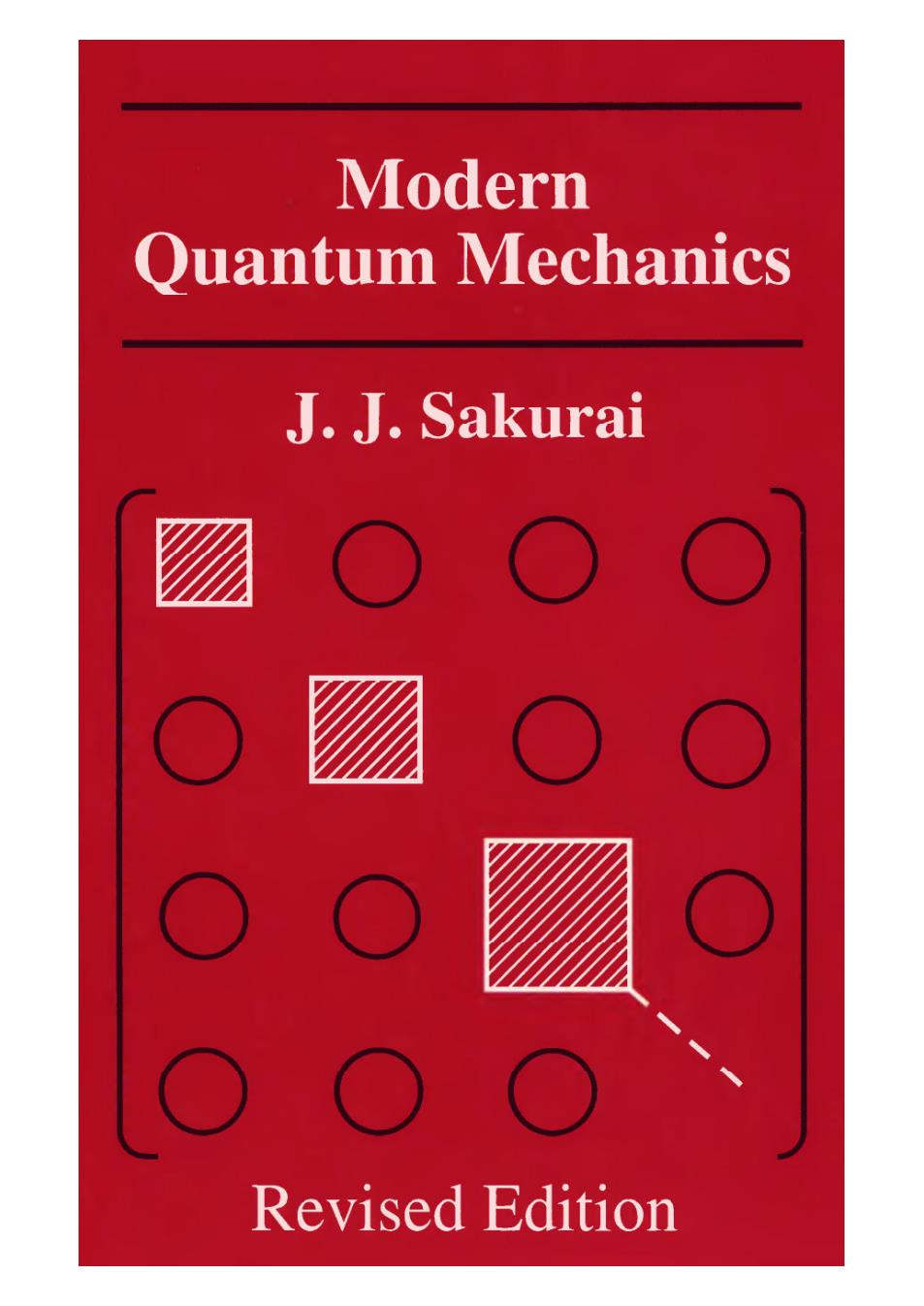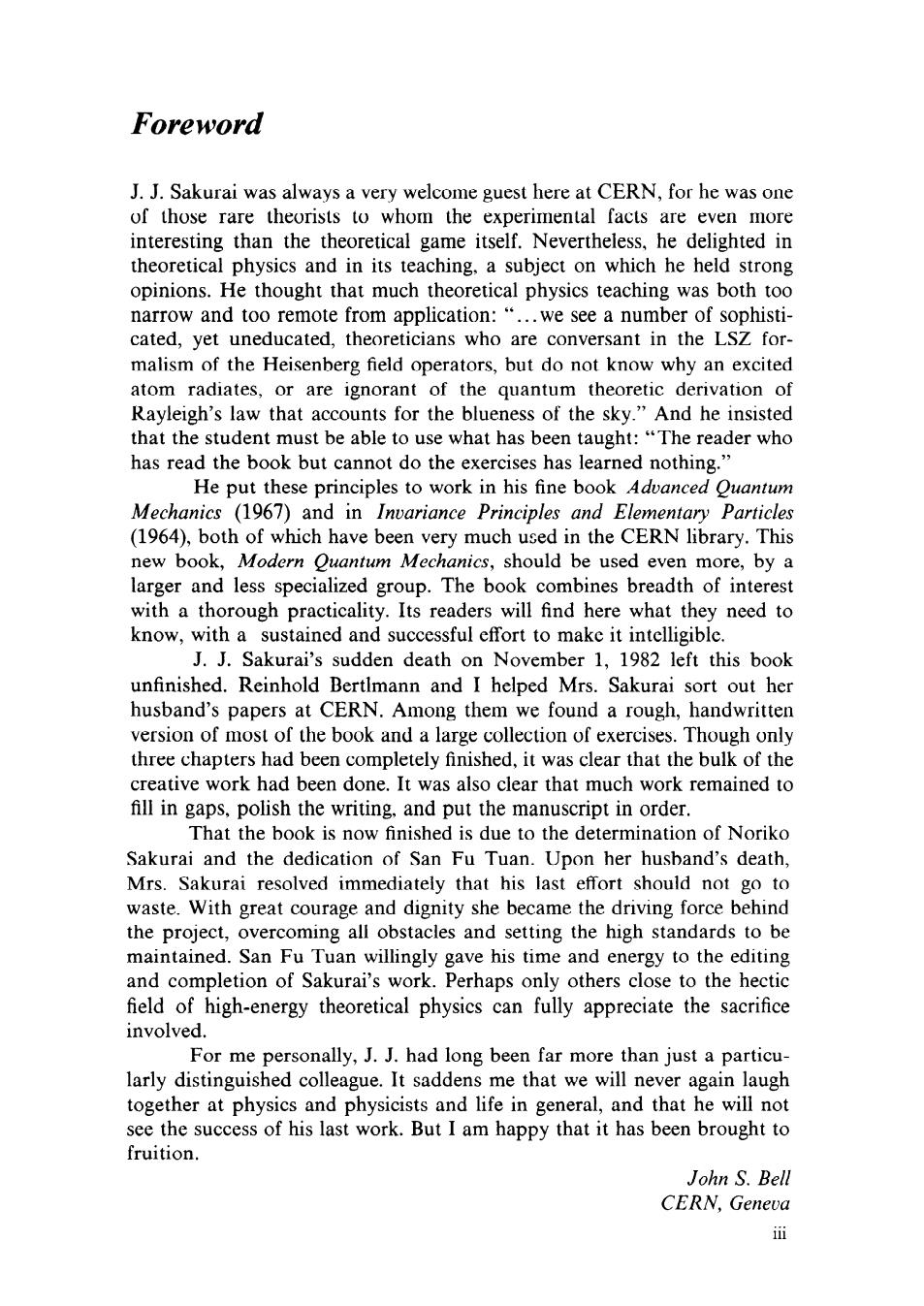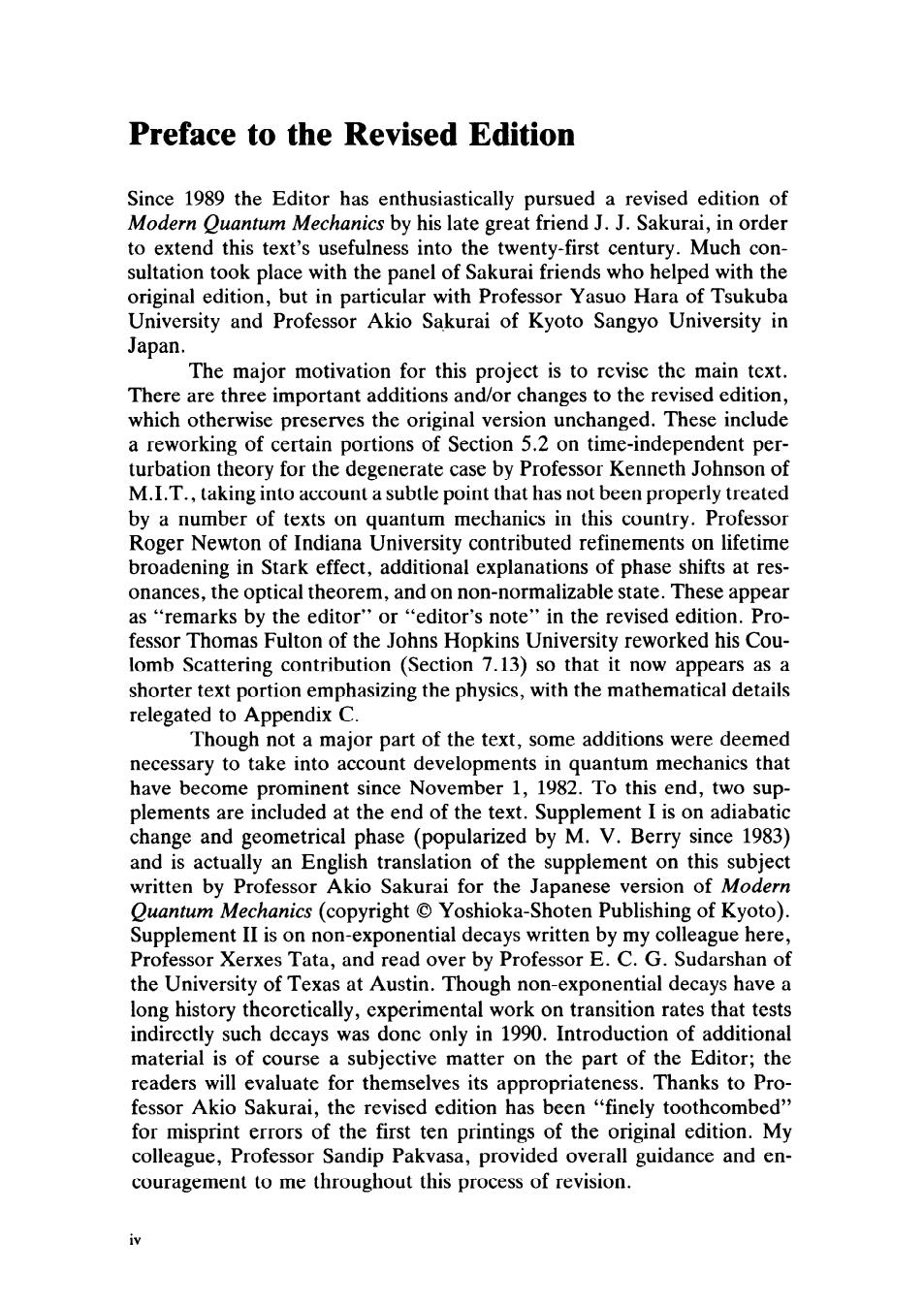
Modern Quantum Mechanics J.J.Sakurai Revised Edition

Foreword of those rare the interesting than the theoretical game itself.Nevertheless,he delighted in theoretical physics and in its teaching.a subject on which he held strong opinions.He thought that much theoretical physics teaching was both too na ..we see a number of so cated.vet uneducated.theoreticians who ars comversant in the Lsphisti for malism of the Heisenberg field operators,but do not know why an excited atom radiates.or are ignorant of the quantum theoretic derivation of Rayleigh's law that acco nts for the bluer ess of the sky."And he insisted that the nt use what has been taught ."The e rea der who has read the book but cannot do the exercises has learned nothing. He put these principles to work in his fine book Advanced Ouantum chamics (1967and in Invariamce Principles and Elementary Particles (1964),both of which have beer used in the CERN library. This new book,Modern Quantum Mechanics,should be used even more,by a larger and less specialized group.The book combines breadth of interest with a thorough practicality.Its readers will find here what they need to know,with a sustained and successful effort to make it intelligible. J.J.Sakurai' sudden death on November 1,1982 left this book unfinished.Reinhold Bertlmann and I helped Mrs.Sakurai sort out her husband's papers at CERN.Among them we found a rough,handwritten version of most of the book and a la e collection of exercis s.Though only three chapters had been completely finished.it was clear that the bulk of the creative work had been done.It was also clear that much work remained to fill in gaps,polish the writing.and put the manuscript in order. That the book is now finished is due to the determination of noriko Sakurai and the dedication of San Fu Tuan.Upon her husband's death Mrs.Sakurai resolved immediately that his last effort should not go to waste.With great courage and dignity she became the driving force behind the project,overcoming all obstacles and setting the high standards to be maintai ined.San Fu Tuan willingly gave his tim and er nergy to the editing completion of Sakurai's work.Perhaps on others cl e to the hectic field of high-energy theoretical physics can fully appreciate the sacrifice involved. For me rsonally,J.J.had long been far more than just a particu larly distingu It saddens me that we will never again laugh together at physics and physicists and life in general,and that he will not see the success of his last work.But I am happy that it has been brought to fruition. John S.Bell CERN,Geneva

Preface to the Revised Edition Since 1989 the Editor has enthusiastically pursued a revised edition of Modern Quantum Mechanics by his late great friend J.J.Sakurai,in order to extend this text's usefulness into the twenty-first century.Much con- sultation took plac with the panel of Sakurai friendswho elped with the original edition,but in partic lar with Professor Yasuo Hara of Tsukuba University and Professor Akio Sakurai of Kyoto Sangyo University in Japan. The major motivation for this project is to rvisc the main text There are three important additions and/or changes to th vised edition which otherwise preserves the original version unchanged.These include a reworking of certain portions of Section 5.2 on time-independent per- turbation theory for the degenerate case by Professor Kenneth Johnson of M.I.T.,taking into account a subtle poin ot that ha snot been properly treated by a number of texts on quantum mechanics in this country.Professor Roger Newton of Indiana University contributed refinements on lifetime broadening in Stark effect,additional explanations of phase shifts at res- onances,the optical theorem,and on non-normalizable state.These appear as"rem arks by the edito or edit r's note in the revised editi fessor Thomas Fulton of the Johns Hopkins University reworked his Cou- lomb Scattering contribution (Section 7.13)so that it now appears as a shorter text portion emphasizing the physics,with the mathematical details relegated to Though not a major part of the text,some additions were deemed necessary to take into account developments in quantum mechanics that have become prominent since November 1,1982.To this end,two sup- mare inded at the end of the text.Supplementison a nge and rical phase (popularized by M.V.Berry since 1983) and is actually an English translation of the supplement on this subjec written by Professor Akio Sakurai for the Japanese version of Modern Quantum Mechanics(copyright Yoshioka-Shoten Publishing of Kyoto) pplement II is on nor onential decays written by my colleague here or Xerxe ata,and over by rofessor E. G.Sudar shan of the University of Texas at Austin.Though non-exponential decays have a long history theoretically,experimental work on transition rates that tests indirectly such decays was donc only in 1990.Introduction of additional material is of co urs subjectiv matter on the part of the Editor;the readers will evaluate for themselves its appropriateness.Thanks to Pro- fessor Akio Sakurai,the revised edition has been "finely toothcombed' for misprint errors of the first ten printings of the original edition.My colleague,Professor Sandip Pakvasa,provided overall guidance and en- couragement to me throughout this process of revision

Preface to the Revised Edition In addition to the acknowledgments above,my former students Li Ping,Shi Xiaohong,and Yasunaga Suzuki provided the sounding board for ideas on the revised edition hen taking my graduate qua ntum me chanics course at the University of Hawaii during the spring of 1992.Suzuki provided the initial translation from Japanese of Supplement I as a course term paper.Dr.Andy Acker provided me with computer graphic assis- tance.The Department of Phy sics and Astronomy and particularly the High Energy Physics Group of the University of Hawai at Manoa provided again both the facilities and a conducive atmosphere for me to carry out my editorial task.Finally I wish to express my gratitude to Physics (and onsoring)Senior Editor,Stuart Johnson,and his Editorial Assistant, Duggan,as well as Senior Production Coordinator Amy Willcut of Addison-Wesley for their encouragement and optimism that the revised edition will indeed materialize. San Fu TUAN Honolulu,Hawaii

In Memoriam Jun John Sakurai was born in 1933 in Tokyo and came to the United States as a high school student in 1949.He studied at Harvard and at Cornell, where he received his Ph.D.in 1958.He was then appointed assistant professor of Physics at the University of Chicago. and became a full professor in 1964.He stayed at Chicago until 1970 when he moved to the University of California at Los Angeles,where he remained until his death. During his lifetime he wrote 119 articles in theoretical physics of elementary particles as well as several books and monographs on both quantum and particle the The discipline of theoretical physics has as its principal aim the formulation of theoretical descriptions of the physical world that are at once concise and comprehensive.Because nature is subtle and complex,the pursuit of theoretical physics requires bold a and enthusiastic ventures to the frontiers of newly discovered phenomena.This is an area in which Sakurai reigned supreme with his uncanny physical insight and intuition and also his ability to explain these phenomena in illuminating physical terms to the Mechanics as well as his reviews and summer school lectures to appreciate this.Without exaggeration I could say that much of what I did understand in particle physics came from these and from his articles and private tutoring. When Sakurai was still a graduate student,he proposed what is now known as the V-A theory of weak interactions,independently of (and simultaneously with)Richard Feynman,Murray Gell-Mann,Robert Marshak,and George Sudarshan.In 1960 he published in Annals of Physics phetic paper,probably his single most important one.It wascon erned with the first serious attempt to construct a theory of strong interactions based on Abelian and non-Abelian (Yang-Mills)gauge invariance.This seminal work induced theorists to attempt an understanding of the mecha- nisms of mass generation for gauge(vector)fields.now realized as the Higgs mechanism.Above all it stimulated the search for a realistic unification o forces under the gauge principle,now crowned with success in the cel- ebrated Glashow-Weinberg-Salam unification of weak and electromagnetic forces.On the phenomenological side,Sakurai pursued and vigorously advocated the vector mesons dominance model of hadron dynamics.He was the first to discuss the mixing of and meson states.Indeed,he made numerous important contributions to particle physics phenomenology in a